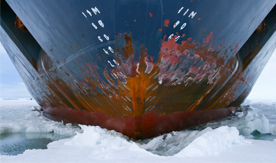
Arctic Research Expected to Provide Unprecedented Views of Phytoplankton
University of Maine research this summer in the Arctic’s Marginal Ice Zone (MIZ) is expected to provide one of the first comprehensive views of the spatial distribution and abundance of phytoplankton under the ice.
UMaine oceanographer Mary Jane Perry, interim director of the Darling Marine Center, was awarded $196,000 from the U.S. Department of Defense Office of Naval Research to sample the biogeochemistry of the Marginal Ice Zone from a Korean icebreaker, the R/V Araon, and with underwater gliders. UMaine scientist Cameron Thompson will participate in additional cruises from Alaska’s Prudhoe Bay; Ivona Cetinic, also at the Darling Center, will be involved in data analysis.
On July 30, Perry will join an international group of over 40 scientists to study the retreat of sea ice in the Arctic. The Arctic has experienced a dramatic decline in sea ice thickness, aerial extent and age distribution. Changing patterns in sea ice have significant implications for the planktonic food web, and flow of carbon and nutrients in the Arctic, including timing, magnitude and location of plankton blooms.
The Marginal Ice Zone Program, led by the University of Washington, is an Office of Naval Research initiative that will use a combination of autonomous robotic technologies, ships, aircraft and satellites to study the breakup of ice in the Beaufort Sea and its northward retreat in summer. It is expected to contribute to our understanding of ice dynamics, including feedbacks in the ice-ocean-atmosphere system that affect rates of sea ice decline. More about the MIZ Program is online, as is a story about the research tracking the breakup of Arctic summer sea ice (washington.edu/news/2014/07/16/tracking-the-breakup-of-arctic-summer-sea-ice).
Perry will use small underwater gliders to repeatedly sample open water, the MIZ and water under full ice cover. The optical data collected from the gliders over a two-month period will offer the first comprehensive view of the spatial distribution and abundance of phytoplankton under ice in the Arctic. Relatively few observations of under-ice blooms exist, due to the logistical constraints of sampling under thin and melting ice.
Thinner ice and greater abundance of melt ponds facilitate greater penetration of visible light through the ice, allowing planktonic photosynthetic organisms to grow. Perry will use measurements from the icebreaker to calibrate the glider sensors. She hopes to assess how changing ice patterns affect plankton productivity in the Arctic, and better understand the role of phytoplankton on the heat budget under the ice.
Phytoplankton are microscopic photosynthetic organisms at the base of the marine food web; their production of carbon fuels the ecosystem. For more than a quarter-century, Perry has studied marine phytoplankton in an effort to understand its biomass variability and production dynamics. Her research has taken her to the subpolar North Atlantic and North Pacific on several major expeditions, the last in 2008, as well as other regions in the world’s ocean.
Contact: Margaret Nagle, 207.581.3745
